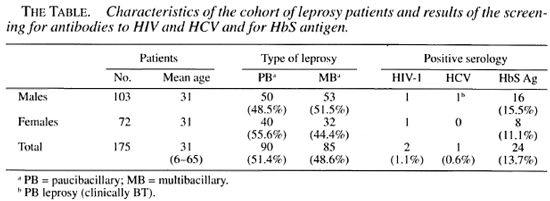- Volume 64 , Number 4
- Page: 453–5
Prevalence of antibodies to hepatitis C among recently treated leprosy patients in senegal parallels those in normal populations
To the Editor:
Recent reports focused on a higher prevalence of hepatitis C (HCV) antibodies (Abs) in leprosy patients than in matched uninfected individuals (3,5). Having followed a 175-patient cohort under field conditions, we do not confirm a higher carriage of hepatitis C among leprosy patients in Senegal, and we suggest that the high levels previously observed might rather be associated with epidemiological conditions within the populations studied.
Infection with Mycobacterium leprae is accompanied by a profound alteration of cellular immunity leading to the different aspects of the leprosy spectrum. Little is known about the exact influence of the lack of T-cell immunity observed in leprosy and the susceptibility to viral infections. In this line, we investigated the seroprevalence to HCV using sequentially 2 third-generation ELISAs (Ortho HCV 3.0®; Chiron Corp., Emeryville, California, U.S.A.; Murex anti-HCV version III, Templehill, England) and an immunoblot assay (Ortho RIBA 3.0.®; Chiron). Genotyping of positive HCV sera was carried out using an ELISA revealing circulating antibodies to recombinant NS4 proteins (Murex HC02) (1). Two other markers of viral infection were also examined, i.e., the presence of hepatitis B virus antigen (HBs Ag) and HIV antibodies using commercially available kits; Monolisa® and Elavia mixte®, respectively (Sanofi-Pasteur, Marne la Coquette, France).
Subjects consisted of 147 newly diagnosed patents and 28 previously treated (monotherapy) patients entering a new survey for the efficacy of a fully supervised, intermittent, single-dose poly-antibiotherapy. Enrollment was done from March to December 1995; patients received full information regarding this investigation and an initial blood sample was taken at the time of the enrollment visit. During the survey, serum was kept in a dry sterile tube at 4ºC (for approximately 12 hr) in the field and then frozen at -20ºC until further assays.
A similar prevalence of the viral markers was found in sera from leprosy patients and a normal population. The HIV antibody prevalence reported here is in line with previous studies conducted on West African populations (2,6). Secondly, the HBs antigen carriage found in this study was not higher than that found in recent determinations that we carried out in the control population belonging to a matched study of hepatitis cases (19% of HBs+) (Renaudineau, Y. and Raphenon, G. Manuscript in preparation).
In addition, in contrast to data from others (3,5), we did not find a higher level of prevalence of HCV in this leprosy population. Two explanations can be proposed: first, the use of third-generation ELISAs leads to more accurate results and probably eliminates false positives; second, the patients enrolled in this study did not live in conditions favoring transmission of HCV (such as observed in leprosarium) associated with promiscuity and/or with poor sanitary conditions (4,5). As a matter of fact, using the third-generation techniques, a relatively low frequency was found recently in a cohort of Senegalese patients suffering from liver diseases (2 out of 67; the HCV+ patients had hepatocarcinoma) as compared to a control population (6 of 943 blood donors). In addition, the HCV antibody-positive leprosy patient was from serotype 2, which is the main circulating serotype since it is found in 80% of the confirmed HCV+ serologies in our overall studies (Renaudineau, Y. and Raphenon, G. Manuscript in preparation).
Taken together, our results suggest that anergy or disorders of the immune system which accompany leprosy are not associated with chronic carriage of hepatitis C when epidemiological conditions for M. leprae -infected patients do not favor hepatitis C transmission.
- Yves Renaudineau, Pharm.D.
Laboratoire de Biologic Clinique
Institut Pasteur de Dakar
Dakar, Senegal
- Ibrahima Mane, M.D.
Institut de Leprologie Appliquée de Dakar
Dakar, Senegal
- Georges Raphenon, M.D.
Laboratoire de Biologie Clinique
Institut Pasteur de Dakar
Dakar, Senegal
- Mbayame Ndiaye Niang, Pharm.D.
Laboratoire d'Immunologie
Institut Pasteur de Dakar
Dakar, Senegal
- Jean-Louis Cartel, M.D.
Institut de Leprologie Appliquée de Dakar
Dakar, Senegal
- Ronald Perraut, Pharm.D., Ph.D.
Laboratoire d'Immunologie
Institut Pasteur de Dakar
36 Av. Pasteur
B.P 220
Dakar, Senegal
Acknowledgment. The authors are very grateful to Drs. I. Pike and J. Botha for providing HCV detection kits; to B. Diouf and Dr. A. Pellegrin for their contributions to this work, and to Dr. O. Garraud for critical reading of the manuscript.
REFERENCES
1. BHATTACHERJEE, V, PRESCOTT, L. E., PIKE, I., RODGERS, B., BELL, H., EL-ZAYADI, A. R., KEW, M. C, CONRADIE, J., LIN, C. K., MARSDEN, H. SAEED, A. A., PARKER, D., YAP, P. L. and SIMMONDS, P. Use of NS4 peptides to identify type-specilic antibody to hepatitis C virus genotypes 1,2,3,4,5 and 6. J. Gen. Virol. 76(1995)1737-1748.
2. BLUM, L, OGOUGBEMY, M , M'BOUP, S., GRIMAUD, J., MILLAN, J., LAUNOIS, P., GAYE, A., LE GUENNO, B., GAYE, A. and FLAGEUL, B. Etude epidemiologique de la seroprevalence de 1'infection par le VIH dans une population hansenienne au Senegal. Acta Leprolo. 8(1922)35-41.
3. DENIS, F., AUSSEL, L., RANGER, S., MARTIN, P., ITOUA-N'GAPORO, A., F ROMMEL, D., TECKLE-HAIMANOT, R. T., SANGARE, A., M'BOUP, S., MILLAN, J. and AL QUDATI, Y. Prevalence of antibodies to hepatitis C virus among patients with leprosy in several African countries and the Yemen. J. Med. Virol. 43(1994)1-4.
4. FAKUNLE, Y. M. and WHITTLE, H. C. Hepatitis-B virus infection in patients with leprosy; a serological study in a leprosarium in northern Nigeria. Trans. R. Soc. Trop. Med. Hyg. 75(1981)623-625.
5. F ROMMEL, D., TECKLE-HAIMANOT, R. T, BERHE, N., AUSSEL, L., VERDIER, M., PREUX, M. P. and DENIS, F. A survey of antibodies to hepatitis C virus in Ethiopia. Am. J. Trop. Med. Hyg. 49(1993)435-439.
6. TOUNKARA, A., FOFANA, Y, DIABATE, N. and SANGARE, D. Etude de la seroconversion anti-VIH chez les lépreux lépromateux au Mali. Méd. Afr. Noire 38(1991)89-91.
Reprint requests to Dr. Perraut at address above or Fax 221-23-87-72; email = perraut@pasteur.pasteur.sn
